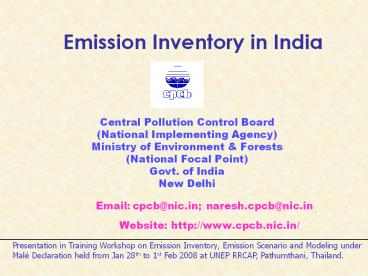Emission Inventory in India - PowerPoint PPT Presentation
1 / 16
Title:
Emission Inventory in India
Description:
Emission Inventory in India Central Pollution Control Board (National Implementing Agency) Ministry of Environment & Forests (National Focal Point) – PowerPoint PPT presentation
Number of Views:104
Avg rating:3.0/5.0
Title: Emission Inventory in India
1
Emission Inventory in India
- Central Pollution Control Board
- (National Implementing Agency)
- Ministry of Environment Forests
- (National Focal Point)
- Govt. of India
- New Delhi
- Email cpcb_at_nic.in naresh.cpcb_at_nic.in
- Website http//www.cpcb.nic.in/
Presentation in Training Workshop on Emission
Inventory, Emission Scenario and Modeling under
Malé Declaration held from Jan 28th to 1st Feb
2008 at UNEP RRCAP, Pathumthani, Thailand.
2
Progress Since Last Intergovernmental Meeting
- Monitoring
- Parameters
- SO2, NO2, RSPM monitoring being continued at
Sunderbans - Planning to initiate ozone monitoring and
meteorological data of IMD station at Sunderbans - No. of Stations
- Discussions being held with SPCBs/PCCs to
increase no. of stations in bordering areas - Advisory Committee revised
- Awareness
- Data of Sunderbans is entered in online software
Environmental Data Bank of CPCB - Information and link to Male Declaration
displayed on CPCB website.
3
Industrial Emission Inventory
Particulate Matter from Different Categories of
Industries
4
Industrial Emission Inventory (contd.)
Sulphur Dioxide from Different Categories of
Industries
5
HC emission load in Nine Metro cities in India
Vehicular Emission Inventory
6
Vehicular Emission Inventory (contd.)
CO emission load in Nine Metro cities in India
7
NOx emission load in Nine Metro Cities in India
Vehicular Emission Inventory (contd.)
8
PM emission load in Nine Metro Cities in India
Vehicular Emission Inventory (contd.)
9
Methodology
- P(i,y) S (j) S(ky) N(j,ky) KT(j) DF(I,j,ky)
EF(I,j,ky).10-9 - Where
- P(i,y) - annual emission of pollutant i in year y
(thousand tonnes per year) - N(j,ky) - number of vehicles of a particular type
j and age ky in year y - KT (j) - kilometers traveled for a type of
vehicle j, km/year - DT(i,j,ky) - Deterioration factor for component i
in vehicle type j and age ky in - year y
- EF(i,j,ky) - Emission factor for component i in
new vehicle type j and age ky - in year y, gm/km
- i pollutant component
- j type of vehicle
- ky age of vehicle in year y
- Source Transport Fuel Quality for Year 2005,
CPCB Report
10
Source Apportionment in Six Cities
- Cities- Delhi, Mumbai, Chennai, Bangalore,
Kanpur and Pune - Scope of Work
- Source Apportionment of PM10 and PM2.5 using CMB
model - Development of Emission Factors for Vehicular
Sources - Development of Source Profiles for Vehicular
Sources - Development of Source Profiles for Non-vehicular
Sources - Emission Inventory for line, point and area
sources - Source Dispersion Modeling- to analyse impact of
various control options - Final Outcome Detailed road-map , short term
and long term measures based on
cost-effectiveness analysis
11
Emission Inventory
- Identify sources of emission under broad
categories of point, area and line sources - Parameters PM10, PM2.5, CO, SO2, NOx, HC
- Collection of secondary data on industrial,
domestic, commercial, vehicular emissions etc - Collection of primary data on different types of
vehicles, average distance traveled etc. - Primary data collection on various industrial,
domestic and commercial sources for zone of
influence ( 2km x 2km) around each monitoring
stations - EF vehicles ARAI study, other sources
common EFs based on literature survey. - City level emission inventory based on secondary
data will be refined based on data generated from
primary surveys - Study under progress
12
Draft Emission Factors for Indian Vehicles
- In-use vehicles of different vintages (Viz,
1991-96, 1996-2000, Post 2000 and Post 2005) were
included in the test matrix to understand the
effect of technology, fuels on emission factors
and give appropriate representation to all kinds
of vehicles plying on Indian roads - The project involved Exhaust Emission testing of
in-use 2 Wheelers, 3 Wheelers, Passenger Cars,
LCVs and HCVs on Chassis dynamometer. - The committee decided to adopt the Indian Driving
cycle for 2-W, 3-W and Pre-2000 4W. Modified
Indian Driving cycle was used for testing for
post-2000 4W. - Parameters measured were CO, HC, NOx, CO2 and PM,
emissions of PAH, Benzene, 1,3-Butadiene,
Aldehydes and Ketones and expressed in mg/km. - Draft Emission Factors put on CPCB website for
comments.
13
Source Profiling of Vehicular Emissions
- Source Profiling of Vehicular Emissions
- Vehicle matrix based on engine technology,
vintage and fuel type - Mass Emission tests on each vehicle
- Gravimetric analysis and chemical
characterization of particulate matter
(elements,OC, EC, ions, molecular markers) - Study under progress
14
Source Profiling of Non-vehicular Sources
- Identified 45 sources including city specific
sources where source apportionment study is being
carried out ( eg. Kerosene combustion, paved road
dust etc.) - Sampling and analysis of combustion and
non-combustion sources - Chemical analysis of samples collected
- Source Profile database development
- Study under progress
15
Emission Inventory under Malé Declaration
- Emission inventory under Malé Declaration is
being carried out for SO2, NOx, PM10, PM2.5, NH3,
CO, NMVOCs using Malé Declaration emission
inventory manual - Data collection under progress
16
- Ø
Thanks































